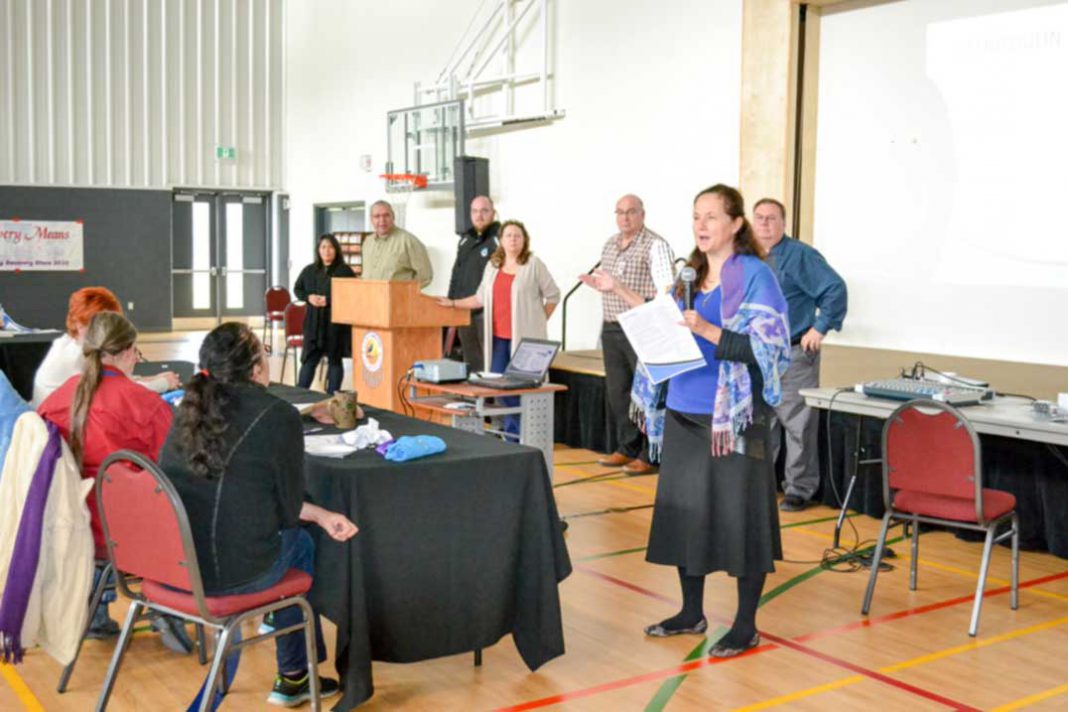AUNDECK OMNI KANING—The Harm Reduction Subcommittee of the Manitoulin Addiction and Mental Health Partners unveiled its Manitoulin Drug Strategy at the National Addictions and Awareness Week Mnidoo Mnising 2016 Gathering held in Aundeck Omni Kaning last week.
“We are pleased to announce the launch of the Manitoulin Drug Strategy today,” said subcommittee member Glen Hallett. “This came about as the result of a group of providers from across the Island who have been meeting and talking about the needs on the Manitoulin. We decided that we needed to do more directed at harm prevention.”
The Manitoulin Addiction and Mental Health Partners include representatives from the Aundeck Omni Kaning Health Centre, Gwekwaadziwin, Health Sciences North: Mental Health and Addictions, M’Chigeeng M’Nendamowin Health Services, Manitoulin Community Withdrawal Management Services, Manitoulin Family Resources, Mnaamodzawin Health Services Inc., Naandwe-Miikan, Noojmowin Teg, North East Manitoulin Family Health Team, Ontario Provincial Police, Sheguiandah First Nation Health Centre and the Sudbury and District Health Unit.
“From concern and willingness to work together, we gather to find solutions to the issue of substance misuse that consumes many lives and impacts many others,” states a document about the strategy from the Harm Reduction Subcommittee. “This drug strategy, reflecting on diverse roots and visionary wings, seeks to find ways to work in collaboration to promote health and prevent substance misuse, restore and maintain community safety and advocate for services and support for people living with addictions and their loved ones.”
“Substance misuse affects all of us,” said Brenda Stankiewicz of the subcommittee. “We have developed a visual drug strategy. The blue that surrounds the image represents the water that surrounds the Island, while the compass in the middle is a nod to Manitoulin’s nautical heritage. In honour of our First Nation partners we have incorporated the medicine wheel colours and arrows tie the image together, symbolizing how all four issues work together.”
Ms. Stankiwewicz explained how the strategy focuses on four key areas: health promotions, community safety, collaboration and services and support.
“Health promotion and education to prevent the misuse of substances is key to developing a community commitment to reducing the harms associated with substance use,” said Ms. Stankiweweicz. “The more we know about substance misuse, the better prepared we will be to act. Community safety, working with enforcement and justice, will ensure people to form a community of care in which we are each responsible for the other. Collaboration and cooperation are building blocks for community development and engagement. Communities working and acting together will ensure that we will all feel included. Service and support includes effort in the areas of harm reduction, treatment and advocacy. As people in need find a caring community to support them on their journey, they will find ways to get well.”
Ms. Stankiwewicz noted that the Manitoulin Municipal Association and many agencies on the Island have reviewed the strategy and endorsed it.
Christine Blake, chair of the Harm Reduction Subcommittee, discussed the next steps of the committee. She said that the committee plans to hold a spring event to garner further community input on the strategy and develop more concrete goals.
The Mnidoo Mnising 2016 Gathering was hosted by the Manitoulin Addiction and Mental Health Partners. In addition to the launch of the new Manitoulin Drug Strategy, there were a number of guest speakers and a panel discussion on recovery.
Dr. Michael Franklyn and Dr. Mel Kahan shared their experiences working in methadone and suboxone clinics. They discussed the challenges for clients and best practices to meet the needs of Northern communities.
During the panel discussion on recovery, individuals with lived experiences shared their stories and experiences regarding what they found helpful to them in the early stages of their recovery and how they have been able to stay on their recovery path.
The keynote speaker was former NHL player Clint Malarchuk sharing his battle with alcoholism, suicide and his battle with mental illness.
Mr. Malarcuk said he grew up with OCD, but channeled it toward the game of hockey and being a goalie. He was drafted to the Quebec Nordiques and went on to play for the Washington Capitals and then the Buffalo Sabres.
In 1989, in a game between the St. Louis Blues and the Buffalo Sabres, a player crashed into the net that Mr. Malarchuk was goaltending and the player’s skate blade hit Mr. Malarchuk’s neck, severing his carotid artery. He lost 1.5 litres of blood and had 300 stitches to close the six-inch wound.
“I went back 11 days later,” he said. “I should have taken time off, but I didn’t. My OCD got bad over the next three years, and I became a drinker, depressed and reclusive.”
His battle with alcoholism and mental health lead Mr. Malarcuk to try and take his own life by shooting himself in the face, but he survived.
Mr. Malarchuk eventually went to rehab and turned his life around, going back to school.
“For me recovery means daily work,” said Mr. Malarchuk, noting how lucky he was to have survived his suicide attempt and to have gotten help.
He talked about how he gets through each day and the mantras that help him.
Mr. Malarchuk’s presentation was followed by a standing ovation and a number of comments from the audience on how his speech touched them.




